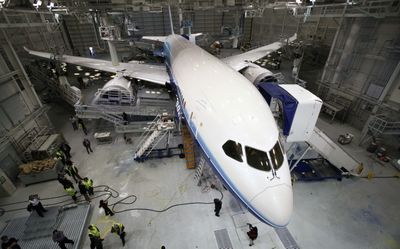787 delayed – again
Structural modifications necessary, Boeing says

SEATTLE – In the fifth major delay to its schedule for flying the 787 Dreamliner, Boeing said Tuesday it has discovered the plane needs added structural reinforcement where the wing and fuselage meet.
The news dealt the 787 program a serious new setback as the window closed on the company’s plan to accomplish first flight by June 30.
When the hot-selling plane will fly is now uncertain: Boeing said it will be “several weeks” before it will even come up with a schedule.
Engineers found a structural defect that dictates “a need to reinforce an area within the side-of-body section of the aircraft,” the company said.
Boeing chief executive Scott Carson said that “structural modifications like these are not uncommon in the development of new airplanes,” and called the fix “a limited and localized structural reinforcement (that) is quite manageable.”
Even before the latest delay, the 787 was nearly two years behind its initial schedule for takeoff.
Boeing said Tuesday that “first flight and first delivery will be rescheduled following the final determination of the required modification and testing plan.”
Richard Aboulafia, an analyst with the Teal Group, said he’s never seen an airplane rollout delayed this close to its first scheduled flight.
“Usually you get to this stage, and there are no show-stoppers,” he said. “That only increases the feeling that there are so many uncertainties here.”
Scott Fancher, the head of the Dreamliner program, explained the structural problem in a conference call. He said that late in May engineers, performing wing bend tests on the airplane that is set aside inside the factory specifically for ground testing, found that strain gauges showed higher stress than predicted by the computer models at multiple points along the upper part of the wing-to-body join.
Boeing executives emphasized that the issue does not represent a fundamental problem with the new carbon-fiber composite plastic material from which the airplane is constructed.
Boeing insists it can fix the problem with a modification to strengthen the structural areas in question. Fancher said that will involve “a relatively small number of parts and a relatively simple modification.”
“We’re talking about a couple of parts that can literally be held in your hand,” at each of the 36 locations affected, Fancher said.
However, given the two years of delays leading up to this last-minute surprise, such assurances have a big credibility problem. The lack of a new schedule is also an issue.
Aboulafia speculated that the 787’s service entry could be delayed until late 2010 or early 2011. Boeing’s original timeline for the Dreamliner called for first delivery in May 2008; until today it was saying the plane would debut with delivery to All Nippon Airways during the first quarter of 2010.
The last-minute delay also further damages Boeing’s credibility, he said. “That’s why that first flight was going to be a very important development. This reinforces the worst opinions of their doubters.”
The news came just a week after Boeing executives at the Paris Air Show, including Carson, offered assurances that the plane would fly by month-end.